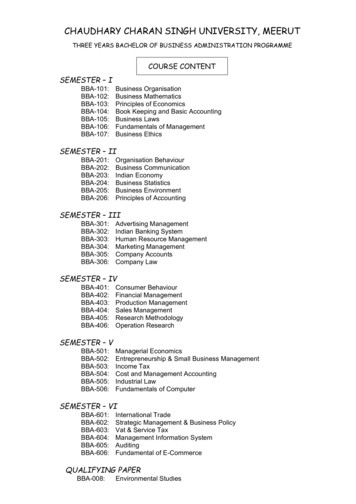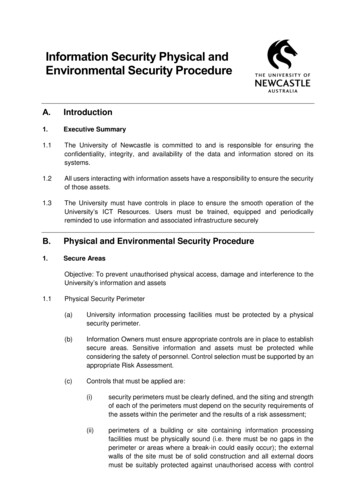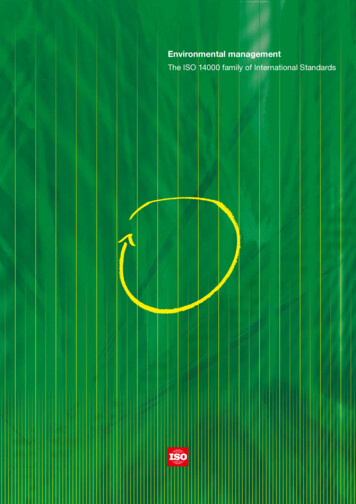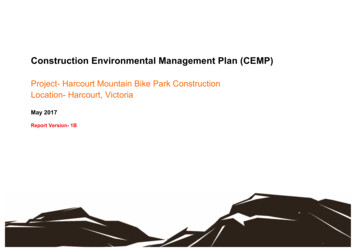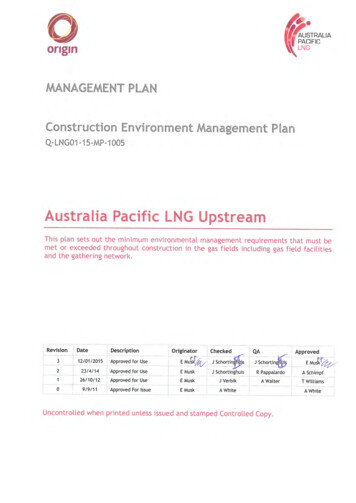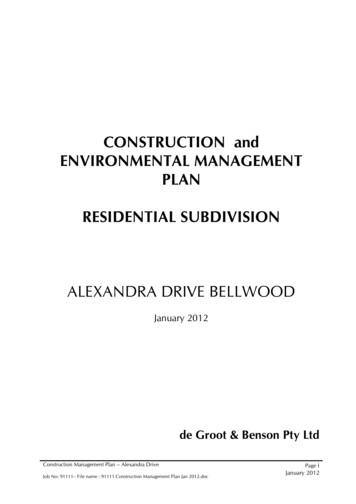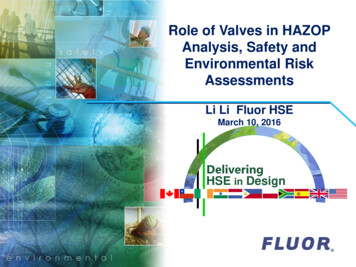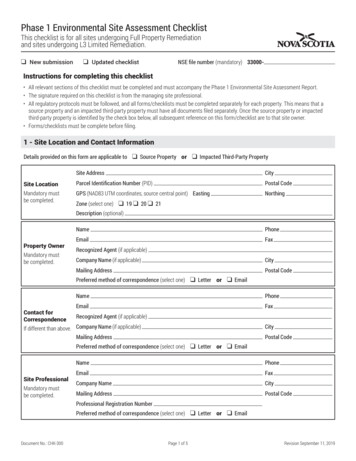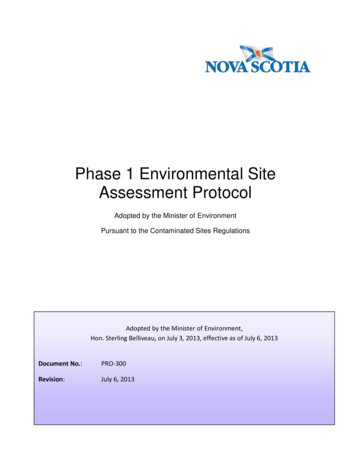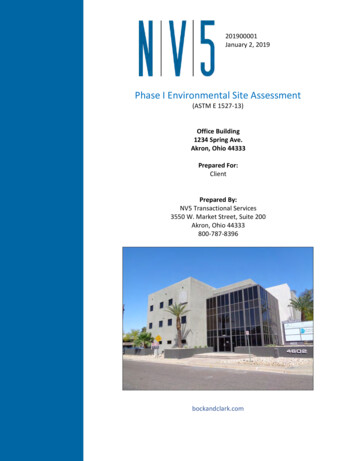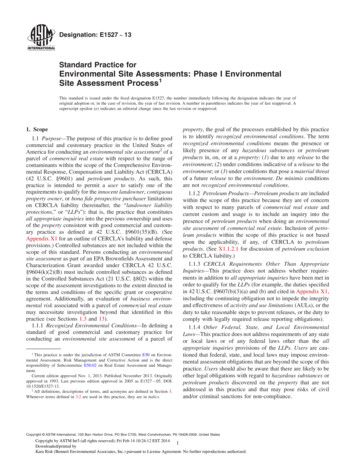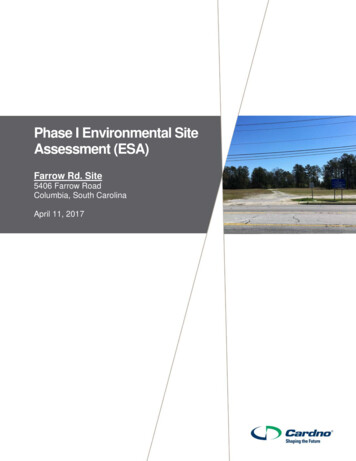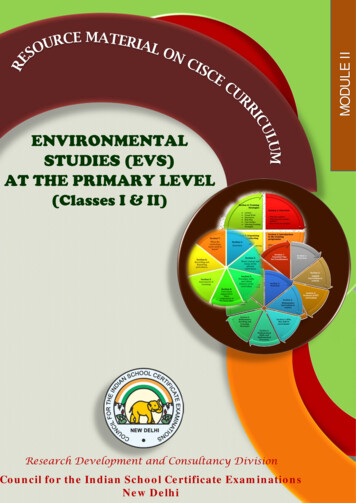
Transcription
MODULE IIENVIRONMENTALSTUDIES (EVS)AT THE PRIMARY LEVEL(Classes I & II)Research Development and Consultancy DivisionCouncil for the Indian School Certificate ExaminationsNew Delhi
Unfolding the Curriculum: EVS Curriculum in PracticeUnfolding the Curriculum: Environmental Studies (EVS)Curriculum in PracticeSection 7:Essential TipsforPractitionersSection 6:Recording andReportingPracticesSection 1:Overview: Why,What and Howof this ModuleEVSModuleSection 5:Assessment ofLearning andReflection onActionSection 2:EVS Curriculum inContext andPracticeSection 3:Features of theEVS CurriculumSection 4:Exemplars inEVS1
Unfolding the Curriculum: EVS Curriculum in PracticeExpectations of this ModuleAfter reading/using this module the user/teacher will be able to: understand the need and significance of this module;understand the nature and status of EVS curriculum;explain salient features of the EVS curriculum and pedagogical principles intheir own words;discuss the need for exemplars in the curriculum and use them in practicalsituations by using hands on activities;relate and frame learning based questions for assessment;understand some essential tips for using curriculum in the classroomsituation.Structure of this Module1. Overview: Why, What and How of this module2. EVS curriculum in context and practice3. EVS curriculum for classes I and II3.1 Salient features of the EVS curriculum3.2 Suggested pedagogical principles for teachinglearning of EVS in the classroom3.3 How should an EVS classroom look like4. Exemplars in EVS4.1 Need for exemplars4.2 Planning for the teaching learning process4.3 Exemplar I4.4 Exemplar II4.5 Exemplar III4.6 Exemplar IV5. Assessment of learning and reflection on action6. Recording and reporting in EVS learning7. Essential tips for practitioners8. Summing up: What have we learnt2
Unfolding the Curriculum: EVS Curriculum in Practice1. Overview: Why, what and how of this moduleWhy this module?This module aims at providing an understanding on various aspects of the EVS curriculumsuch as its status in early grades (Class I & II), salient features, pedagogical principles for EVSlearning and what makes an EVS classroom a happy classroom. It would also provide a clarityon various components of the EVS curriculum such as learning outcomes, identified conceptsin selected themes, transactional processes and learning resources. Apart from this, themodule would develop confidence among users to contextualize in their specific situations.In order to understand all the components of the teaching learning process, some exemplarshave also been given.What does this module include?This module has seven sections. The first section provides an overview to explain why, whatand how to use the module. Section II gives the status and nature of the EVS curriculum incontext. Section III explains salient features and pedagogical principles. Section IVfocuses on exemplars which cover planning, implementation and assessment during theteaching learning process. Section V deals with reflection and assessment of learning(assessment after completion of theme/unit) and suggestive assessment practices.Section VI details out recording and reporting in EVS learning and finally Section VIIprovides some tips to the practitioners/users.How to use this module?This module is meant for all stakeholders i.e. practicing teachers, master trainers and schooladministrators working at the primary level in particular and for primary teachers in general.In each section of this module, some activities have been provided. These activities need tobe done after completing each section. Four exemplars have also been given for this subject,which may be used in a classroom situation. After using the exemplars, peer reflection shouldbe taken which would help to further improve the module.Activity-1 (Pair Work)Let us doDiscuss in groups the three benefits of this module for teachersand master trainers. Make a list.3
Unfolding the Curriculum: EVS Curriculum in Practice2. EVS curriculum in context and practiceNature and StatusEVS learning provides an opportunity for children to explore, investigate and develop anunderstanding of the natural, human, social and cultural dimensions of the local and widerenvironments. This area enables children to live as informed and caring members of the local,national and global communities at large.Keeping its significance in view, EVS has been kept as one of the curricular areas inClasses I and II. The major focus area of this subject is - learning for the environment,learning about the environment and learning through the environment. Thus, in this subject,the concepts, issues and concerns related to the social, natural and cultural environment needto be transacted in an integrated manner. Treating natural environment (science) andsocial-cultural environment in isolation is to be discouraged (disciplinary approach). Athematic approach is necessitated to be followed to provide a holistic perspective of theenvironment. Due to the thematic nature of the subject, the content/concepts would bederived from the child’s family and immediate surrounding. The nature of this subject isprocess based and therefore emphasis should be placed on development of skills.InformationTechnologyPhysicalSciencesLife ScienceEarth ScienceEnvironmentalStudiesSocial andCulturalNumericalSkillsArts EducationLanguage andCommunicationFigure 1: Interdisciplinary and Integrated perspective of EVSEVS content and skills utilize the teaching-learning process effectively in a way that the social,emotional and attitudinal values of the children are interwoven with the acquisition ofknowledge, skills rather than teaching them as an add on activity or in an isolated manner.4
Unfolding the Curriculum: EVS Curriculum in PracticeWhy EVS LearningThe major objectives of EVS teachinglearning is to enable children to: learn about the environment- bydeveloping an awareness of the natural,social and cultural environment. It dealswith issues/concepts in an integratedmanner through various themes andactivitiesrelatedtodailylifeexperiences, e.g. family, friends, plantsand animals, etc.learn through the environment lays emphasis on using various objects,places, plants and animals in theimmediate environment as learningresources;learn for the environment emphasizes inculcation of values,attitudes and skills related to protectionof the environment;enhance/promote curiosity andcreativityinrelationtothesurroundings;develop an appreciation fordiversity (language, family, habits,variations in plants, animals, culture,etc.) in the surroundings;develop sensitivity towards seniorcitizens, people with disability anddisadvantaged groups of society,focusing on their strengths as well as theareas of concern.Broad Skills/ Processes that EVS LearningPromotes:1. Observation and Reporting – Exploring,sharing, narrating and drawing, picturereading, making pictures, collecting andrecording information.2. Discussion - Listening, talking, expressingopinion,3. Expression – Expressing through gestures/body movements, expressing verbally,expressingthroughdrawing/writing/through creativesculpting,4. Explanation – Reasoning, making ns, formulating one’s ownreasoning.5. Classification - Identifying objects-based onobservable features, identifying similaritiesand differences in objects, sorting/grouping6. Questioning – Expressing curiosity, askingquestions and framing simple questions.7. Analysis – Defining situations/ events,identifying/predicting possible causes of anyevent/situation.8. Experimentation (Hands - on activities) –Improvising, making simple things and.performing simple9. Concern for Justice and Equality –Developing a sensitivity towards thedisadvantaged or people with special needs/disability, showing concern for the10. Cooperation –Taking initiatives, sharing andworking together withActivity - 2Let us do Why does EVS learning need to be integrated in nature ratherthan a disciplinary one? Give two reasons. Write any two features of a theme-based curriculum.5
Unfolding the Curriculum: EVS Curriculum in Practice3. EVS curriculum for classes I and IISalient features of EVS curriculumSalientFeaturesTheme-basedand integratedapproach tolearningChild-centredapproachRange oflearningexperiencesSpiral approachto learningWhat does it mean?ExamplesThe present curriculum encourages a ‘themebased’ rather than a ‘topical’ approach in thiscurricular area. Thus, it does not proceed with a listof topics where focus is on coverage of content.Instead of moving from one topic/ isedmanner,thepresentcurriculum encourages an integrated approach toteaching-learning, so as to enable children tocomprehend learning experiences as a unifiedwhole. The curriculum aims to help children makesense of life’s experiences by helping them connectand correlate knowledge and experiences acrossvarious topics within as well as across subjectareas.The two subjects of Science andSocialStudieshavebeenintegrated into one core area ofEVS. The content has beenpresented through themes ratherthan topics. For e.g.In the theme ‘Water’ the contentof the theme is related to thechild’s life experiences ratherthan facts connected with it.The curriculum gives primacy to children’sexperiences and their active participation. Theidentified concepts, skills, pmentallyage-appropriatewiththeunderstanding of the child progressing graduallyfrom self to the immediate surrounding andfurther to the wider environment.In order to follow a child centredapproach in EVS, the learningprocess followed under eachtheme moves from simple tocomplex, concrete to abstract,informal to formal in a logicaland phased manner.(e.g. food in the family sourcesof food conservation of food)Recognising different learning styles andindividual differences among children, the EVScurriculum suggests a wide range of learningexperiences and transactional strategies. Thus, thecurriculum aims at ensuring that learning is ajoyful experience for all children and that they areable to understand not only what they learn, butalso how this learning is relevant in their lives, bothfor the present and the future.Using various strategies varyingfrom classroom discussions, casestudies, field visits, role play,project work, surveys, ng, poster making, sloganwriting, etc. have been suggestedin the EVS curriculum.As children progress, they will revisit certainconcepts/themes which are repeated consciouslyas an entry level behaviour to build new learning.However, the depth and complexity of thetheme/concept will increase with each revisit. Thenew knowledge would be put in the context of thepre-existing knowledge which would serve as abase or the foundation for the next level oflearning.Planning lessons taking intoaccount prior knowledge andexperiences of the children. Thus,the new learning would be builton the previous experiences of thechild.6
Unfolding the Curriculum: EVS Curriculum in PracticeSalientFeaturesHolistic approachto learningScope lues and LifeSkillsWhat does it mean?ExamplesDifferent domains of learning, i.e., cognitive,affective and psychomotor (head, heart, hand)have been dealt with in an integrated mannerrather than addressing them in isolationwithin/across the themes.In the Exemplar on the theme‘Water’ you will find learningoutcomes of all the threedomains. i.e. cognitive, affective& psychomotor.The curriculum provides flexibility to schools toadapt and contextualize as per their ownrequirements and the needs of the children. Whilethe key concepts under each theme have been speltout for this area in the curriculum, it is expectedthat the teachers would adapt and use appropriatetransactional processes, based on the resourcesavailable, the interests and aptitude levels ofchildren, as well as their geographical locationsand the socio-economic and cultural contexts. Designing activities and citingexamples that are relevant forchildren in terms of lifeexperiences and their localcontexts. Helpingchildreninconnecting and applying theirlearningtohomeandcommunity. Using learning resources thatare locally available.This approach lays emphasis on learning by doing(I do, I understand much better). Also, childrenlearn better while interacting/discussing withelders/peers. Thus, this approach providesopportunities for children to construct theirknowledge rather than placing them as recipientsof information in the transactional process. Theknowledge gained by them is thus an outcome ofthe children’s involvement in the learning process.Engaging/involving children inexploring,observing, discovering the world around them,helps in the process of construction of knowledge. Providing opportunities forcollaborativeandgrouplearning through interactionwith peers and elders (grouplearning). Providing opportunities aswellasthenecessaryresources to enable childrento experiment, explore anddiscoverforthemselves(learning by doing). Creating an environment inthe class where the childrenfeel safe to ask questions (nonthreatening environment). Prompting inquiry by askingthought provoking, openended questions (opportunityfor development of soft skills).The values and life skills are not to be developed inisolation and are not ‘add on’ activities, rather,these are to be developed in an integrated andinfused manner from this curricular area. (Ageappropriate skills and life skills have beenmentioned in the curriculum as a reference pointfor teachers).While dealing with all the themesin EVS, one of the considerationsis to inculcate values and developlife skills as per the nature of thetheme e.g. in the theme ‘Water’conservation of water and itsjudicious use must be emphasisedas a value and life skill.7
Unfolding the Curriculum: EVS Curriculum in PracticeMajor Components of EVS curriculum EVS learning needs to be theme-based rather than topic based as suggested in the syllabus/curriculum. Therefore, in each identified theme, the concerns and issues related to physical,social and cultural context of the environment should be discussed holistically and criticallyso that the child can make informed choices. These themes are continued from Class I to Class II. Other themes may be included as perthe need and context.The following themes have been identified for the EVS Curriculum:Suggested Themes for Environmental StudiesTime,Space andDirectionThe WorldAroundMe:Sun,Moon, Skyand StarsCommunicationAbout MeOthers inMy WorldEVSClasses I & IIIssues/concerns/conceptsrelated to:Science LearningSocial Studies LearningLearning related toEnvironmentin an integrated and infusedmannerTransportAnimalsMy n, Safeand HealthyPlaces in theNeighbourhoodPlants Each theme in the EVS curriculum (refer to Page 120), begins with the need and significanceof the theme (why this theme?). You need to not only understand the purpose of giving thetheme but also how to deal with it. This is followed by the learning outcomes related to the theme. If you study these outcomes,you will find that these learning outcomes cover different aspects of the child’s behaviour, i.e.knowledge, comprehension, skills, values/ attitudes. These learning outcomes aredevelopmentally age-appropriate in nature. These are the essential learning outcomesidentified for this stage; however, you can add relevant learning outcomes keeping in view theneed, context and interest of the children. For better understanding on learning outcomesrefer to Module-1, i.e., Understanding the Curriculum.8
Unfolding the Curriculum: EVS Curriculum in oncepts/AreasLearningResourcesThe curricular components of EVS have been dealt with in three columns.ThemeLearning OutcomesKey Concepts Suggested TransactionalProcesses Suggested LearningResources In the first column, key concepts have been mentioned. In column 2, suggested transactionalprocesses have been given. These transactional processes have been identified keeping in viewthe following: Class/Grade Nature of the theme Key Concepts Learning OutcomesFor example, the Theme 2, ‘Others in my World’, covers key concepts related to the child’sfamily, celebrations in the family and neighbourhood, keeping in view the social and culturalaspects. The identified pedagogy would be - sharing personal experiences and discussions,narrating experiences of family festivals, assigning simple projects, drawing pictures of familymembers/ friends. The learning resources would also be selected to meet out the need of thepedagogical processes. For example, puppet show can be a good learning resource to describefamily members’ roles, habits as well as relationships between family members. Similarly,flash cards on festivals can help teachers discuss various festivals celebrated in differentfamilies (various variations in celebrations could be covered.) In column 2, Suggested Transactional Processes have been given. The EVS learning in earlyclasses is process based, therefore the transactional practices need to be guided by skills andprocesses such as describing, observing, identifying, etc. These processes would make EVSclassrooms more child-centred and activity-based. In the third column, suggested learning resources have been mentioned. The learningresource(s) mean any action or material which enhances the learning process. For example,while dealing with Theme 2, “Others in My World’, children’s own experiences (verbal action),9
Unfolding the Curriculum: EVS Curriculum in Practiceclassroom discussions (verbal actions), flash cards (concrete material), children’s drawings(nonverbal actions) are some examples of Learning Resources that may be used. In each theme, at the end of the Curriculum presentation, integration of EVS with othersubjects has also been highlighted. The implication of this reference is that wherever thereare linkages, they should be addressed simultaneously, rather than dealing with them inisolation. For example, creative expression through drawing, paper work, origami, claymodelling, etc. relate to the Art Education curricular area as well. While dealing with suchskills/ activities, the subject boundaries must be diffused and learning outcomes of bothsubjects may be addressed. Life Skills/ Values, healthy habits have also been addressed in the curriculum of EVS. Theinfused approach has been followed while dealing with life skills. While transacting thecurriculum, life skills should be dealt with in context and in an integrated manner with theEVS concepts by taking suitable examples.Suggested pedagogical principles in teaching- learning of EVS Active participation of children is important in constructing knowledge. Opportunitiesshould be given for observations using a variety of learning resources such as visits to parks,museums, water bodies and various places in the community. If learning occurs beyond thewalls of classrooms, the quality of learning is better. Efforts should be made by teachers to relate the child’s local knowledge to the schoolknowledge - this would discourage rote memorization and encourage developmentally ageappropriate learning in EVS. Children in early grades learn through a variety of ways, therefore opportunities should begiven to explore, observe, draw, categorise, discuss/ speak, ask questions and enlist, etc. todevelop various skills /processes. Textbook is one of the learning resources both for children and teachers. Other learningresources such as family members and community, newspapers, books and worksheets, etc.should be used for better learning. While interacting with parents/elders, children not onlycollect past information but also get the opportunity to develop discussion/ questioning skills. Pictures /illustrations play a very important role in EVS learning as these support the writtenmaterial. Picture readings/visual based activities should be encouraged which would not onlyprovide joy but also pose a challenge to children. Activities and questions play an important role as these provide opportunities for childrento express themselves. Thus, activities/questions should not be used only for assessingchildren but also to develop skills such as creative expression, observation, classification,explanation, etc. in children. Each child learns at his /her own pace. The challenge before the teacher is to handle multilevelgroups so as to address the needs of children including the differently challenged group ofchildren. Teachers should design activities for these children in such a manner so that theycan be engaged meaningfully while doing activities with their peer group. Assessment for learning (formative assessment), should be used as an inbuilt part of theteaching learning process so as to identify and address learning gaps in a timely manner.Thus, formative assessment should not be used for reporting progress but for diagnosticpurpose to improve children's learning and to develop their potential. The real purpose of assessment of learning (summative assessment) is not to compare theprogress of children but to track the progress of each child regularly. This assessment shouldbe done periodically by using a variety of modes (not restricted to the written mode only). The teacher should maintain a portfolio of each child and this document should be used as an‘assessment tool’ to know the progress of each child over a period of time. The portfolio shouldinclude the work done by the child in a variety of situations, covering various aspects of the10
Unfolding the Curriculum: EVS Curriculum in Practicechild’s behaviour. An e-portfolio can be maintained by teachers to reduce the task of recordingwork. Teachers must understand that learning is a mutual process. Children learn from each otherand a teacher also learns from children, particularly to understand their needs. EVS learning is also concerned with the inculcation of important values/ attitudes andappreciation. It fosters an appreciation of the interrelationship between all living organismsand their environments and encourages children to become active agents in the conservationof the environment. EVS learning cultivates a respect for cultural diversity and sensitizes children regarding theminorities and people with special needs. Prejudices and discrimination are challenged, whilerespect and mutual understanding are promoted.What should an EVS classroom look like?An EVS classroom should be a child centered and happy classroomwhere children get opportunities to: observe, explore, ask question, do activities, share experiencesduring the learning process; conduct a variety of activities ranging from cognitive (head),affective (heart/emotions) and conative (hands/ manipulative); construct their own knowledge by using their own experiencesand a variety of learning resources inside and outside the classroom; work individually, in small and large groups, as per the needs of the children as childrenlearn more through interaction; reflect on their own work and also on the work of the peer group/ others’ work; learn to appreciate others’ work and learn to respect others’ point of view.Flexible seating, games, puzzles, displays, artefacts, films,posters, charts, costumes, puppets, etc. should form a part ofan EVS classroom.Activity-3Let us doWrite any two salient features of EVS learning which are differentfrom language learning.11
Unfolding the Curriculum: EVS Curriculum in Practice4. Exemplars in EVS4.1 Why do we need exemplars?The underlying idea for exemplars is to: enable practitioners to translate the curriculum into practice in the classroom; help teachers understand the different components of the teaching-learning processesin a sequential manner; understand how to translate learning outcomes of the selected concepts in theclassroom context.4.2 How do we plan the Teaching-Learning Process in EVS? Select a theme/lesson;Brainstorm for ideas to develop a concept map (one example is given below);Concept Map for Exemplars 1 and 2 (Theme: Water)Uses ofwater-Vessels forstorage-Need forstorageStorage ofwater-In the family-Plants-AnimalsSources ofwater-Sources at home-Sources in lepropertiesof waterSavingwaterQuestioning**-Judicious use-Reuse*Theme**Processes/skills (How to learn) Select learning outcomes from the curriculum and write key learning points ofidentified concepts;Select activities and identify an appropriate pedagogical process to developconcepts/skills;Select relevant and appropriate (locally available) learning resource material.12
Unfolding the Curriculum: EVS Curriculum in Practice4.3 Some essentials for EVS classroom transaction:The EVS curriculum is thematic in nature; therefore, the content of EVS needs to be drawn fromthe child’s life experiences. To make the EVS learning more experiential, the teaching-learningstrategies need to: be contextual and related to real-life experience.be age and developmentally appropriate and diverse.be designed so that all the senses (touch, feel, taste, smell, sight, auditory) are involved.encourage participation of all children (participatory).provide opportunities for hands-on-activities for all children.provide opportunities for sharing of experiences/ideas (rather than the correct answer)and reflection.use environmental objects and ‘environment’ as learning resource.provide freedom to children to express themselves.be designed so that assessment for learning and assessment as learning are an inbuiltpart of the classroom transaction.In addition, the teacher needs to be a patient listener and giver.13
Unfolding the Curriculum: EVS Curriculum in Practice4.3 Exemplar 1Class ITheme: WaterKey Concept: Uses of waterLearning Outcomes:Children will be able to:share personal experiences related to use of water;identify and give examples of activities done with and without water;draw a picture of an activity done with or without water;write in a sequence the activities done using water in a day from morning to night;classify activities according to less and more use of water;group the activities based on the use of water at home and in the surroundings.Classroom Transaction:Pedagogical ProcessesLearning Points:StrategiesClassroom InteractionBrainstorming and While taking up any new theme, brainstormingand discussion may be initiated on that theme, to Activities done discussionknow the initial learning level of children. Thiswith water andprocess would help the teacher to develop awithout watertheme/concept map. Uses of water atIntroduce the concept of this theme by having ahome and in thediscussion and asking the children a question like:surroundings What did you do yesterday from morning tonight e.g. eating breakfast, sleeping, ?Note their responses on the blackboard.Now ask children to identify activities thatwere common to all children out of the abovementioned activities.The children will respond by naming thecommon activities they did from morning toevening.You may then ask, the difference betweensleeping and bathing; playing and brushingactivities.The children’s response would be: For sleeping we do not use water whereas forbathing we use water. For brushing we use water but not forplaying. You can now display a variety of items suchas: a glass of water, a glass of juice, kneadedflour, wet clay, a water painting, a water spray.14
Unfolding the Curriculum: EVS Curriculum in PracticePedagogical ProcessesLearning Points:StrategiesClassroom Interaction Observe and identifyDrawing skillEstimation(Cross Curricularlinkage)You can also display on the display board avariety of pictures depicting activities donewith and without water. Give an opportunity to the children to observeand discuss about the displayed items andpictures. Children will identify activities donewith the use of water and otherwise.Ask the children to draw a picture of an activitythat they did using water and without water. Nowask the children to share their work with theirpeers. Ask the children which activity will requiremore water?a. Brushing teeth or taking a bathb. Painting a picture or painting a roomc. Filling a bucket or filling a tankd. Watering a plant or washing a car Arrange these activities on the basis ofconsumption of water (high to low).Assessment for Learning This can be done by giving children worksheets, drawing andcolouring activities with and without the use of water.Ask children to think of activities they did the day before andlist 3 activities that they did with water and three withoutwater.Ask children to draw a picture of any one activity that they liketo do, which involves use of water and one without water.15
Unfolding the Curriculum: EVS Curriculum in PracticePedagogical ProcessesLearning Points:StrategiesGroup activityFor the Teacher:You can make your ownworksheet based on thelearning outcomes relatedto the concepts.Classroom InteractionAsk children to narrate their personal experiencesabout how they and their family members usewater e.g. for cooking, cleaning, doing laundry,bathing, etc. They can also describe theirexperiences about the use of water observed bythem during their journey from home to schoole.g., plants being watered, animals in water, etc.Now children can be asked to classify theactivities of use of water at home and in thesurroundings. You can note their observations onthe blackboard as mentioned below:HomeSelfFamilySurroundingsPlantsAnimalsAfter this activity, a discussion can be initiated.Individual activity Ask all the children to note down the activities(seat work)they do using water from morning to night. Letthem write these in a sequence.Let the children share their observations in smallgroups. Ask
Unfolding the Curriculum: EVS Curriculum in Practice . 4 2. EVS curriculum in context and practice . Nature and Status. EVS learning provides an oppor
